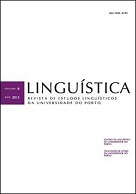Deadjectival human nouns: conversion, nominal ellipsis, or mixed category?
Abstract
Whereas deadjectival nouns referring to humans such as the Germans have been analyzed as the result of morphological conversion, the human construction the rich in English has been analyzed as a special case of nominal ellipsis. In this paper counterarguments are presented against the ellipsis analysis, mainly focusing on the human construction in Dutch, which has mixed adjectival and nominal properties. Traditionally, deadjectival human nouns ending in the suffix –e are analyzed as the result of morphological derivation. In the ellipsis analysis the suffix –e is analyzed as an inflectional suffix rather than a derivational one, licensing an empty noun. The plural suffix –n and the determiner would provide the human interpretation. In this paper an analysis in the framework of Distributed Morphology is proposed, which is a combination of the ellipsis analysis (without an empty noun) and the traditional derivational/conversion analysis.
References
Ackema, P. & Neeleman, A. 2004. Beyond Morphology. Interface Conditions on Word Formation. Oxford & New york: Oxford University Press.
Alexiadou, A. 2001. Functional Structure in Nominals: nominalization, and ergativity. Amsterdam & Philadelphia: John Benjamins.
Alexiadou, A., Iordăchioaia, G. & Schäfer, F. 2011. Scaling the variation in Romance and Germanic nominalizations. In: P. Sleeman & H. Perridon (Eds.). The Noun Phrase in Romance and Germanic: Structure, variation and change, [Linguistik Aktuell/ Linguistics Today, volume 171]. Amsterdam & Philadelphia: John Benjamins, 25-40.
Belder, M. De. 2011. A morphosyntactic decomposition of countability in Germanic. The Journal of Comparative Germanic Linguistics 14(3): 173-202.
Borer, H. 2005. In Name Only. [Vol. 1 of Structuring Sense]. Oxford: Oxford University Press.
Borer, H. & Roy, I. 2010. The name of the adjective. In: P. Cabredo-Hofherr; O. Matushansky (Eds.). Adjectives: Formal analyses in syntax and semantics. [Linguistik Aktuell/Linguistics Today 153]. Amsterdam & Philadelphia: John Benjamins.
Borsley, R.D. & Kornfilt, J. 2000. Mixed extended projections. In: R.D. Borsley (Ed.). The Nature and Function of Syntactic Categories. New york: Academic Press, 101-131.
Chierchia, G. 1998. Reference to kinds across languages. Natural Language Semantics 6(4): 339-405.
Chomsky, N. 1970. Remarks on nominalization. In: R. Jacobs; Rosenbaum, P. (Eds.). Readings in English Transformational Grammar. Waltham, MA: Blaisdell, 184-221.
Chomsky, N. 1981. Lectures on Government and Binding. Dordrecht: Foris.
Corver, N. & Koppen, M. van. 2009. Let’s focus on NP-ellipsis. GAGL (Groninger Arbeiten zur germanistischen Linguistik) 48: 3-26.
Depiante, M. & Masullo, P. 2004. Gender is in the lexicon, number is in the syntax: evidence from nominal ellipsis in Spanish. Paper presented at GLOW 27, Thessaloniki. Don, J. 2005. On conversion, relisting and zero-derivation. A comment on Rochelle Lieber: English word-formation processes. SKASE Journal of Theoretical Linguistics 2(2): 2-16.
Eguren, L. 2009. Adjectives and deleted nominals in Spanish. In: E. Aboh, E. van der Linden, J. Quer & P. Sleeman (Eds.). Romance Languages and Linguistic Theory. Selected Papers from Going Romance 2007. Amsterdam & Philadelphia: John Benjamins, 67-86.
Embick, D. 2004. On the structure of resultative participles in English. Linguistic Inquiry 35(3): 355-392.
Embick, D. & Noyer, R. 2006. Distributed Morphology and the Syntax/Morphology interface. In: G. Ramchand & C. Reiss (Eds.). Oxford Handbook of Linguistic Interfaces. Oxford: Oxford University Press, 289-324.
Geerts, G., Haeseryn, W., De Rooij, J. & van den Toorn, M. 1984. Algemene Nederlandse Spraakkunst. Groningen: Wolters-Noordhoff.
Giannakidou, A. & Stavrou, M. 1999. Nominalization and ellipsis in the Greek DP. Linguistic Review 16: 295-331.
Halle, M. & Marantz, A. 1993. Distributed Morphology and the pieces of inflection. In: K. Hale; S. J. Keyser (Eds.). The View from Building 20. Cambridge, MA: MIT Press, 111-176.
Halle, M. & Marantz, A. 1994. Some key features of Distributed Morphology. MIT Working Papers in Linguistics 21: 275-288.
Harley, H. & Noyer, R. 1999. Distributed Morphology. Glot International 4(4): 3-9.
Hulst, H. van der & Kooij, J.G. 1997. Prosodische keuzes bij meervoudsvorming in het Nederlands. In: A. van Santen & M. van der Wal (Eds.), Taal in Tijd en Ruimte. Voor Cor van Bree bij zijn afscheid als hoogleraar Historische Taalkunde en Taalvariatie aan de Vakgroep Nederlands van de Rijksuniversiteit Leiden. Leiden: SNL, 365-373. Kester, E.-P. 1996a. The Nature of Adjectival Inflection. PhD dissertation, Utrecht University.
Kester, E.-P. 1996b. Adjectival inflection and the licensing of empty categories in DP. Journal of Linguistics 32(1): 57-78.
Kornfeld, L. & Saab, A. 2002. Nominal ellipsis and morphological structure in Spanish. In: R. Bok-Bennema, B. Hollebrandse, B. Kampers-Manhe & P. Sleeman (Eds.), Romance Languages and Linguistic Theory 2002. Selected Papers from Going Romance. Amsterdam & Philadelphia: John Benjamins, 183-198.
Kranendonk, H. 2010. Quantificational Constructions in the Nominal Domain: Facets of Dutch Microvariation. PhD dissertation, Utrecht University.
Lobeck, A. 1995. Ellipsis, Functional Heads, Licensing and Identification. Oxford: Oxford University Press.
Panagiotidis, P. 2001. Empty nouns. Natural Language and Linguistic Theory 21: 381- 432.
Plann, S. 1981. The Two el + infinitive Constructions in Spanish. Linguistic Analysis 7: 203-240.
Rizzi, L. 1986. Null objects of Italian and the theory of pro. Linguistic Inquiry 17: 501- 557.
Sleeman, P. 1996. Licensing Empty Nouns in French. The Hague: Holland Academic Graphics.
Sleeman, P. 2001. Deverbale procedés in het Nederlands en het Frans. In: L. Beheydt & P. Godin (Eds.). Contrastief Onderzoek Nederlands-Frans. Bibliothèque des Cahiers de l’Institut de Linguistique de Louvain 108, 195–209.
Sleeman, P. 2010. The nominalized infinitive in French: structure and change. Linguística. Revista de Estudos Linguísticos da Universidade do Porto 5: 145-173.
Svenonius, P. 1992. The extended projection of N: identifying the head of the noun phrase. Working Papers in Scandinavian Syntax 49: 95-121.
Van den Toorn, M.C., 2008, 9th edition. Nederlandse Grammatica, www.dbnl.org/tekst/ toor004nede01_01/toor004nede01_01.pdf (first edition: 1984. Groningen: Wolters- Noordhoff).
Downloads
Published
Issue
Section
License
Copyright (c) 2017 Linguística Revista de Estudos Linguísticos da Universidade do Porto

This work is licensed under a Creative Commons Attribution-NonCommercial 4.0 International License.



